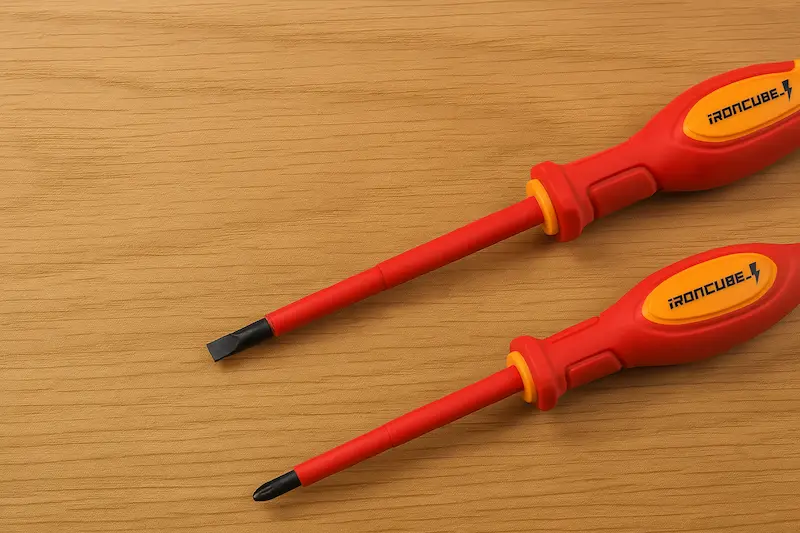When working with electrical systems, the difference between life and death often hinges on choosing the right tools. Every year, electrical accidents claim hundreds of lives and result in thousands of preventable injuries, some of which could have been avoided by using the appropriate insulated screwdriver. Understanding what constitutes a true safety insulated screw driver—and why VDE certification is so important—is not just technical knowledge; it is critical survival information for anyone involved in electrical work.
Professional electricians, maintenance technicians, and even DIY home users face electrical hazards every day. Incorrect tool selection can not only lead to equipment damage but also cause electric shocks, burns, or even fatal electrical accidents. This guide will provide a comprehensive overview of insulated screwdriver-related knowledge, with a particular emphasis on VDE testing standards, to help you distinguish between truly safe tools and dangerous counterfeits.
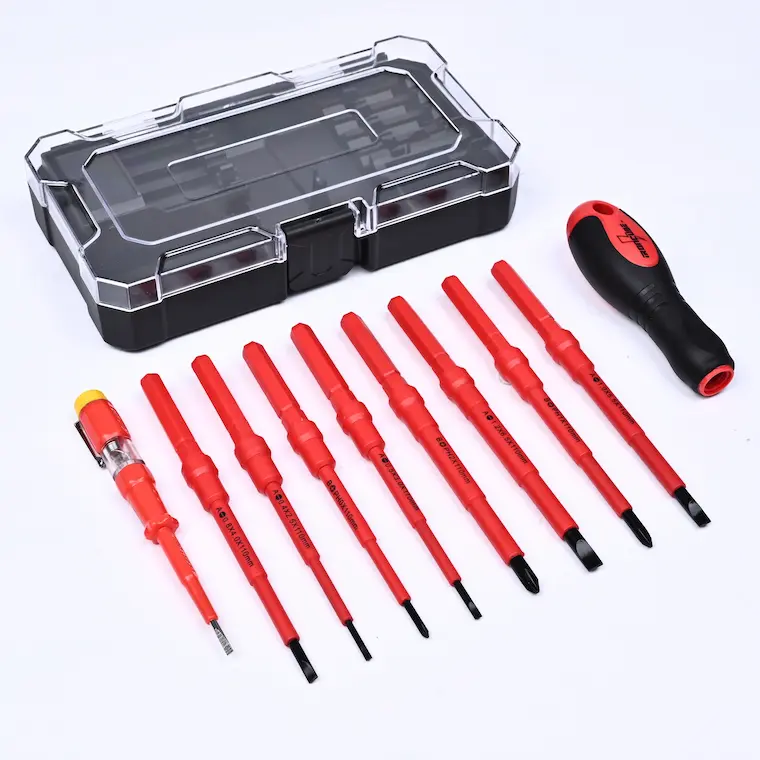
What is an Insulated Screwdriver?
An insulated screwdriver is a specialized electrical tool designed with multi-layer insulation to protect users from electrical shock when working on live circuits or in environments where accidental contact with energized conductors is possible. Unlike standard screwdrivers, these tools feature carefully engineered insulation systems that meet strict electrical safety standards.
What is a Screwdriver? Complete Guide to Types, Uses & Selection
Ratchet Wrench Mechanical Design
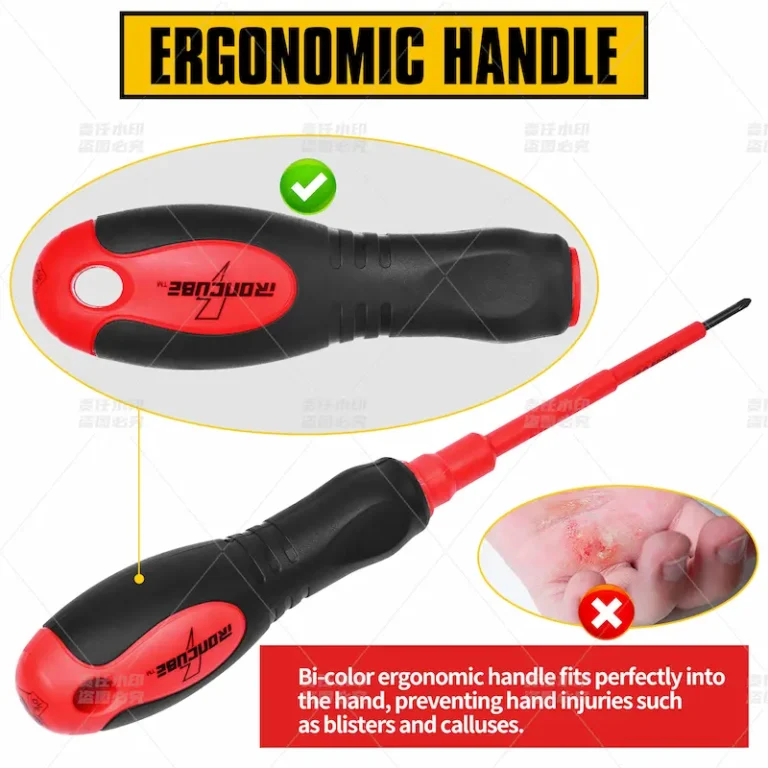
Electrical Insulation Principles
The insulation on these screwdrivers works by creating a barrier that prevents electrical current from traveling through the tool to the user’s body. This protection relies on specific dielectric materials—typically specialized polymers—that can withstand high voltages without breaking down or conducting electricity.
Multi-Layer Protection Design
Professional insulated screw drivers employ multiple insulation layers, not just a simple plastic coating. The inner layer directly contacts the metal shaft and provides the primary electrical barrier. The outer layer adds mechanical protection and ensures the inner insulation remains intact even under harsh working conditions.
Critical Safety Function
These tools enable electricians to work safely on live circuits up to their rated voltage—typically 1000V AC. This capability is essential for troubleshooting, testing, and maintenance work where de-energizing circuits isn’t practical or possible. Without proper insulation, contact with live conductors through a standard screwdriver can result in electrical shock, burns, or electrocution.
Check the Complete Guide to Types of Ratcheting Wrenches: Everything You Need to Know in 2025
Professional vs Consumer Distinction
True electricians screwdrivers differ significantly from hardware store tools with basic plastic handles. Professional insulated screwdrivers undergo rigorous testing, carry specific voltage ratings, and meet international safety standards. The difference isn’t just quality—it’s the difference between certified protection and false security that could prove fatal.
VDE Certification: Why VDE Testing is Critical for Electrical Safety
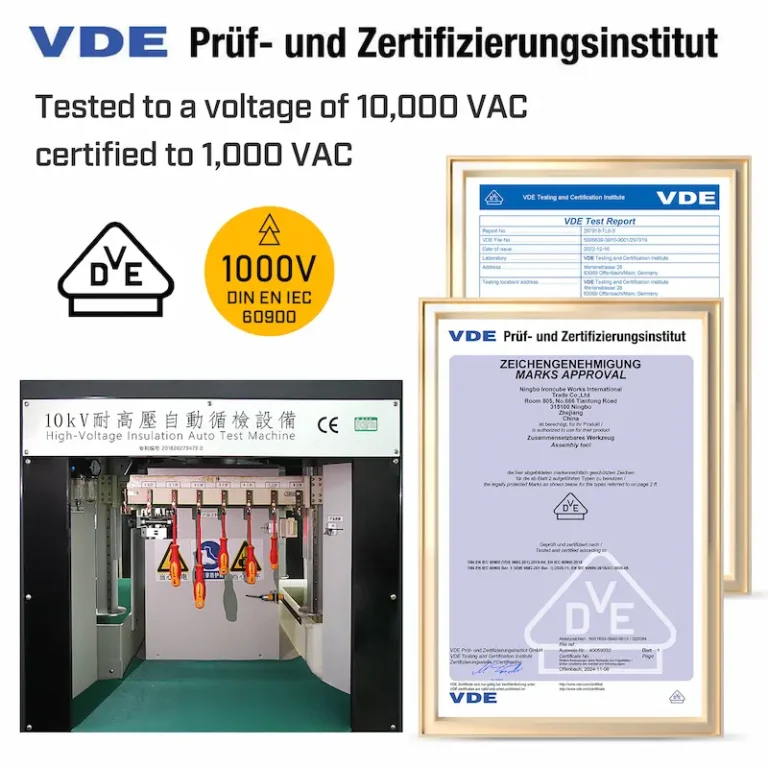
VDE certification represents the highest standard in the field of electrical tool safety and is issued by the VDE Testing and Certification Institute, Germany’s leading electrical safety testing agency. For electrical professionals, understanding VDE standards is not optional but rather core knowledge directly related to personal safety and professional responsibility. Especially for insulated screwdrivers, VDE certification represents a safety threshold.
VDE Testing Standards Excellence
VDE-certified tools are tested at 10,000 VAC (alternating current voltage) to ensure reliable operation at the certified working voltage of 1,000 VAC. This 10:1 safety margin is not arbitrarily set—it takes into account voltage spikes, transient phenomena, and insulation material aging that may occur in actual electrical environments.
Rigorous Certification Process
VDE testing involves multiple stages, including initial design review, material testing, production sample verification, and ongoing quality monitoring. The tools must pass electrical breakdown testing, mechanical stress testing, environmental adaptability testing, and long-term aging studies. This comprehensive approach ensures that the tools maintain consistent safety performance throughout their entire service life.
Why VDE Testing Matters
The 10,000V test voltage provides a critical safety margin for the following reasons. Electrical systems may experience voltage spikes due to factors such as lightning strikes, switching operations, and equipment failures, which can temporarily exceed normal operating voltages. Additionally, insulation materials may degrade over time due to factors such as mechanical stress, temperature cycling, and chemical exposure. The high test voltage ensures that protective functions remain effective even as materials age.
2025 The Best Multi Ratcheting Screwdriver Set Guide
International Recognition and Standards
VDE standards align with the IEC 60900 international standard and often exceed minimum requirements. This alignment ensures that VDE-certified tools meet global safety standards, making them the preferred choice for international contractors and multinational corporations that require consistent safety standards across all operations.
Legal and Insurance Implications
Many jurisdictions require the use of certified electrical tools for professional work, and insurance policies may exclude claims involving accidents caused by uncertified equipment. VDE certification provides written proof of due diligence in tool selection, thereby protecting electricians and their employers from legal liability.
Construction and Materials: How Insulated Screw Drivers Provide Protection
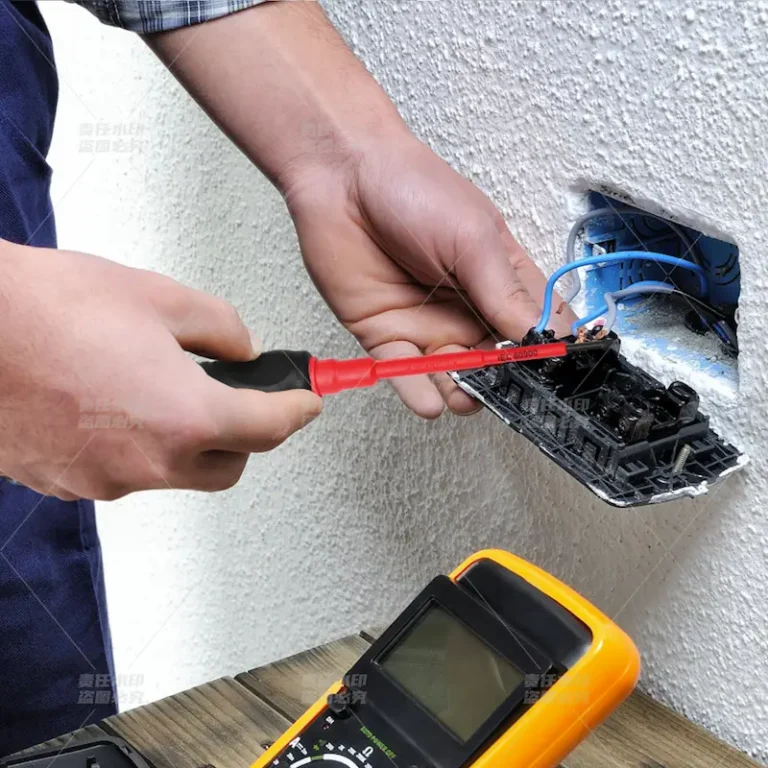
The engineering behind effective electrical insulation involves sophisticated material science and precision manufacturing that goes far beyond simple plastic coating. Understanding these technical details helps electricians select tools that provide genuine protection rather than cosmetic appearance of safety.
Advanced Insulation Materials
Professional insulated screwdrivers are made from special thermoplastic elastomers and engineering polymers designed specifically for electrical insulation. These materials maintain their dielectric properties across a wide temperature range (-40°F to +160°F) while resisting common electrical work environment hazards such as oil, solvents, and mechanical wear.
Check The Ironcube tool guide hand tools that actually work
Precision Manufacturing Requirements
The insulation coating process requires precise control of material thickness, adhesion, and coverage. Gaps, bubbles, or weak areas in the insulation layer can become failure points for electrical breakdown. High-quality manufacturers use injection molding or dip coating processes and strictly control quality to ensure uniform insulation layer thickness and complete coverage.
Dual-Layer Insulation System
High-end insulated screwdrivers feature a dual-layer insulation structure. The inner layer is typically 1–2 millimeters thick and serves as the primary electrical barrier, maintaining its insulation performance even if the outer layer is damaged. The outer layer provides mechanical protection, features anti-slip textures, and is color-coded to indicate voltage ratings and tool identification information.
Handle Design Integration
The insulation system extends to the handle design, ensuring no exposed metal is accessible to the user. Proper design includes insulated sleeve rings, non-conductive handle materials, and precise treatment of transition zones where metal meets insulation layers. These details prevent partial discharge and ensure complete electrical isolation.
Quality Control and Testing
Each insulated screwdriver undergoes individual testing during manufacturing, rather than merely sampling. Testing includes electrical breakdown testing, visual inspection for defects, and dimensional verification. Reputable manufacturers mark each tool with certification marks, voltage ratings, and traceability codes to verify its authenticity as a certified genuine product.
Voltage Ratings and Safety Standards for Insulated Screwdrivers
Understanding voltage ratings and safety standards is crucial for selecting appropriate tools and using them safely within their designed limitations. Misunderstanding these specifications can lead to tool selection errors with potentially fatal consequences.
Standard Voltage Classifications
Most professional insulated screwdrivers are rated for 1000V AC, suitable for standard electrical distribution systems. Some specialized tools offer a 600V rating to meet specific application requirements, while others can handle higher voltages for transmission line work. The rated voltage represents the maximum safe operating voltage, not a recommended value for working on live circuits at that voltage.
AC vs DC Considerations
Voltage ratings are typically specified for AC values, but many tools also indicate DC ratings. Due to differing electrical stress mechanisms, DC breakdown voltages differ from AC values. Professional electricians working on DC systems (solar installations, battery systems, electric vehicles) must verify DC ratings separately.
Safety Margins and Real-World Conditions
The 10,000V test requirement for 1000V-rated tools provides necessary safety margins for multiple critical factors. Electrical systems can experience transient overvoltages due to switching operations, lightning strikes, and equipment failures. Additionally, insulation materials degrade over time, reducing their breakdown strength. High test voltages ensure tools provide adequate protection throughout their entire service life.
International Standards Compliance
IEC 60900 provides an international framework for insulation tool standards, while regional standards such as ASTM F1505 (United States) and EN 60900 (Europe) offer local implementation details. VDE certification typically exceeds these minimum standards, providing additional safety assurance for demanding professional applications.
Environmental Factors
Voltage ratings assume specific environmental conditions, including temperature, humidity, and contamination levels. Extreme conditions—high humidity, salt fog, chemical exposure—may reduce insulation performance. Professional electricians must consider these factors when selecting tools for specific work environments.
Professional Applications: When to Use Insulated Screwdriver Sets
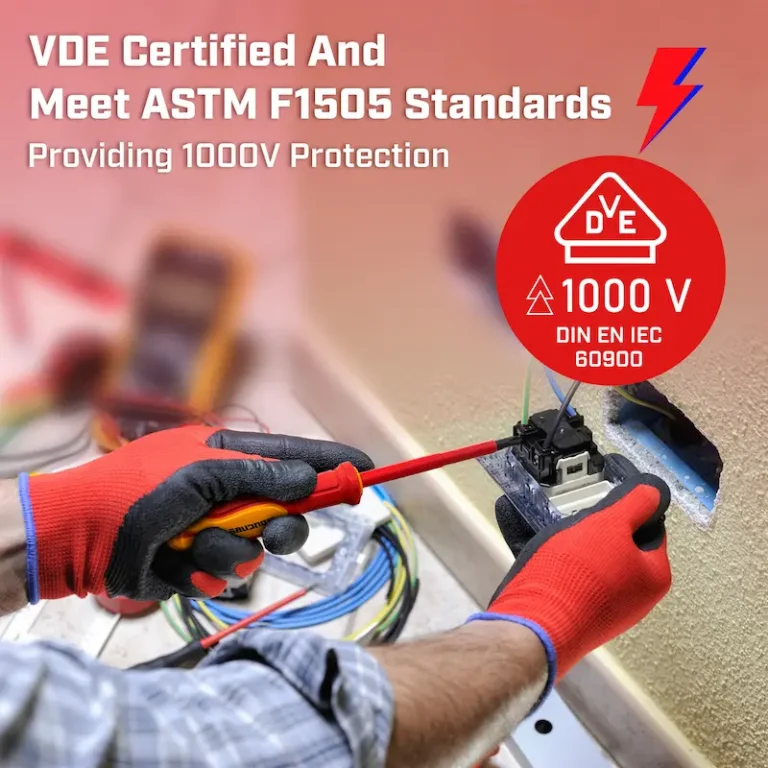
Professional electrical work encompasses diverse applications where insulated screw driver sets provide essential protection. Understanding when and how to use these tools safely requires knowledge of both their capabilities and limitations.
Residential Electrical Installation
Residential electrical work involves 120V/240V systems, and insulated screwdrivers provide essential safety protection during work in distribution boxes, outlet installations, and circuit fault troubleshooting. Even circuits that appear to be “de-energized” may carry dangerous voltages due to reverse power supply, improper switch operation, or parallel circuits. Insulated tools can effectively prevent such accidental energization.
Commercial and Industrial Maintenance
Commercial buildings and industrial facilities often operate multiple voltage systems simultaneously—combinations of 120V/208V/480V are common. Maintenance work frequently requires working inside live distribution panels, where insulated tools are not only recommended but essential for safety and often legally mandated.
Motor Control and Variable Frequency Drives
Modern motor control systems generate complex waveforms and high-frequency components, which may subject insulation systems to stresses exceeding DC or standard AC ratings. VDE-certified insulated tools provide protection against the increasingly stringent electrical environments common in industrial settings.
Emergency Repair Situations
Emergency electrical repairs are often performed in high-voltage environments where it is difficult to verify that the circuit is completely de-energized. Power outages, equipment failures, and safety incidents require immediate response, and taking the time to verify complete de-energization may not be practical. Insulated tools provide necessary protection in these high-pressure situations.
Live Circuit Diagnostics
When troubleshooting electrical faults, it is often necessary to measure and adjust live circuits. Insulated screwdrivers allow safe contact with terminal blocks, adjustment of potentiometers, and testing of points while the circuit is live, enabling accurate diagnosis.
Compliance and Liability Considerations
Many electrical codes, insurance policies, and employer safety programs require the use of certified insulated tools for electrical work. Using the appropriate tools demonstrates due diligence and professionalism while providing legal protection in the event of accidents or incidents.
How to choose an insulated screwdriver set?
Selecting the right insulated screwdriver set requires balancing safety requirements, application needs, budget constraints, and quality considerations. Professional electricians need tools that provide reliable protection while offering the versatility to handle diverse electrical tasks efficiently.
Basic Insulated Screwdriver Set Configuration: A basic electrician’s insulated screwdriver set should include Phillips screwdrivers (No. 1, No. 2, No. 3), flathead screwdrivers (1/8″, 3/16″, 1/4″), and specialty screwdrivers for common electrical applications. This minimum configuration of seven pieces can meet 90% of standard electrical work needs while keeping tool inventory manageable.
Premium Insulated Screwdriver Professional Set: Full sets can be expanded to 10-15 pieces, including larger sizes, specialty bits (square head, Torx head), and precision screwdrivers for control panels and electronic components. These sets are suitable for electricians who frequently contact a variety of fasteners in multiple industries and types of facilities.
Brand Quality Considerations: Professional brands such as Klein, Wera, and Wiha dominate the market with their excellence in safety and durability. However, emerging manufacturers such as IRONCUBE are offering VDE-certified quality products at very competitive prices, making professional-grade safety guarantees accessible to more electricians and maintenance professionals.
Sets vs. individual pieces: A full set offers cost advantages and ensures consistent quality across all tools, while individual pieces allow for customization to meet specific job needs. Most professionals find that starting with a quality set of tools, supplemented with individual specialty tools, offers the best balance of coverage and cost effectiveness.
Storage and organization: Quality tool sets come in organized cases that protect tools and ensure easy identification. This organization is not only convenient, it’s also safer. Being able to quickly identify and select the right insulated tool can prevent dangerous mistakes such as grabbing a non-insulated tool in an emergency job situation.
Understand what is a ratcheting wrench
IRONCUBE Insulated Screwdriver Sets: Professional-Grade Electrical Safety Tools
IRONCUBE has emerged as a significant player in professional electrical tools by focusing on VDE-certified safety at accessible price points. Their insulated screwdriver sets demonstrate that professional-grade electrical safety doesn’t require premium pricing, making certified protection available to a broader range of electrical professionals.
IRONCUBE Professional Insulated Screwdriver Set
The comprehensive IRONCUBE set includes eight essential drivers covering Phillips (#1, #2, #3), flathead (3mm, 4mm, 5.5mm, 6.5mm), and specialty configurations. Each tool carries full VDE certification with 1000V AC rating, tested to 10,000V AC according to rigorous German safety standards.
Technical Specifications and Safety Features
IRONCUBE tools feature dual-layer insulation systems with 2mm inner insulation providing primary electrical protection and reinforced outer layers offering mechanical protection and enhanced grip. The insulation extends fully into the handle transition zones, eliminating potential failure points where many cheaper tools compromise safety.
VDE Certification Compliance
Every IRONCUBE insulated screwdriver undergoes individual electrical testing during manufacturing, not just batch sampling. The tools meet IEC 60900 standards while exceeding minimum requirements in several areas including mechanical strength, environmental resistance, and long-term insulation stability.
Ergonomic Design Excellence
The handle design incorporates professional feedback from working electricians, featuring optimal diameter for extended use comfort and textured grips that maintain effectiveness even with oily or wet hands. The color-coded insulation allows quick tool identification while the laser-etched markings ensure permanent voltage rating visibility.
Value Proposition Analysis
IRONCUBE sets typically retail for 40-60% less than equivalent Klein or Wera sets while maintaining comparable safety certifications and build quality. This pricing makes VDE-certified safety accessible to apprentice electricians, small contractors, and maintenance departments with limited tool budgets.
Professional User Feedback
Field reports from electricians using IRONCUBE tools indicate satisfaction with durability, safety performance, and value. The tools have demonstrated reliable performance in demanding commercial and industrial environments, with users appreciating the combination of certified safety and reasonable pricing.
Purchase Recommendations
For electricians requiring VDE-certified safety on limited budgets, IRONCUBE sets provide excellent value. The tools are particularly well-suited for apprentices learning the trade, small electrical contractors, and maintenance professionals who need certified tools without premium pricing.
How to use an insulated electrician's screwdriver?
Proper use of insulated screwdrivers extends beyond simply selecting certified tools—it requires understanding safe work practices, tool limitations, and maintenance requirements that preserve safety performance throughout the tool’s service life.
Pre-Use Inspection Protocol: Before each use, inspect insulated screwdrivers for damage including cracks, cuts, missing insulation, or exposure of underlying metal. Any visible damage renders the tool unsafe for electrical work. Pay particular attention to the tip area and handle transition zones where stress concentrations can cause insulation failure.
Voltage Verification Requirements: Never assume circuits are de-energized. Use proper voltage testing equipment to verify absence of electrical energy before beginning work. Even when using insulated tools, following lockout/tagout procedures and testing for voltage provides essential additional layers of protection against electrical accidents.
Proper Tool Selection: Use tools rated for the actual system voltage plus appropriate safety margins. Working on 480V systems requires 1000V rated tools, not 600V rated ones. Consider transient overvoltages, system fault conditions, and potential measurement errors when selecting appropriate voltage ratings.
Work Environment Considerations: Wet conditions, metal surfaces, and confined spaces increase electrical hazards and may require additional safety measures beyond insulated tools. Consider using insulated gloves, insulating mats, and ensuring proper egress routes when working in challenging environments.
Tool Limitations Understanding: Insulated screwdrivers protect against electrical shock through the tool itself but don’t protect against arc flash, arc blast, or burns from electrical faults. Proper arc-rated PPE and safe work practices remain essential even when using insulated tools.
Emergency Procedures: Ensure other personnel know your location when working with electrical systems and have established communication protocols. Keep electrical emergency contact information readily available and ensure fire extinguishers appropriate for electrical fires are accessible.
Common Misconceptions About Insulated Screwdrivers
Several dangerous misconceptions about insulated screwdrivers persist in the electrical industry, leading to unsafe practices and inadequate tool selection. Understanding these misconceptions can prevent serious accidents and ensure appropriate safety measures.
Insulated Screw driver Misconception - All Plastic Handles Provide Insulation
Standard screwdrivers with plastic handles are NOT electrically insulated tools. The plastic used in standard handles isn’t designed for electrical insulation and hasn’t been tested for voltage breakdown. These tools provide no electrical protection and can fail catastrophically when exposed to electrical voltage.
Insulated Screw driver Misconception - Insulation Lasts Forever
Insulation materials degrade over time due to mechanical stress, temperature cycling, UV exposure, and chemical contamination. Regular inspection and periodic replacement are essential for maintaining safety performance. Most manufacturers recommend replacing insulated tools every 3-5 years in professional use.
Insulated Screwdriver Misconception - Higher Voltage Rating is Always Better
Using tools rated for higher voltages than necessary doesn’t provide additional safety—it may indicate older technology or unnecessary expense. Modern 1000V tools provide excellent protection for standard electrical systems while offering optimal size and ergonomics.
Insulated Screwdriver Misconception - VDE Certification Doesn't Matter
Some electricians believe any insulated tool provides adequate protection, but testing standards vary dramatically. Only VDE or equivalent certified tools undergo rigorous testing and quality control necessary for reliable electrical protection. Non-certified tools may fail without warning.
Insulated Screw driver Misconception - Cost Determines Quality
While extremely cheap tools are typically unsafe, high price doesn’t guarantee better safety performance. Focus on proper certifications (VDE, IEC 60900 compliance) and reputable manufacturers rather than price alone when selecting safety-critical tools.
Insulated Screwdrivers Misconception - Visual Inspection is Sufficient
Electrical insulation can fail internally without visible external damage. Professional electrical testing equipment can verify insulation integrity, but most field applications rely on regular replacement schedules and proper inspection protocols rather than electrical testing.
Conclusion
Insulated screwdrivers represent essential safety equipment for any electrical professional, with VDE certification providing the gold standard for electrical protection. The rigorous testing requirements—10,000V AC testing for 1000V AC certification—ensure reliable protection against electrical hazards that could otherwise prove fatal.
VDE Certification Importance: The comprehensive testing and quality control required for VDE certification provides confidence that tools will perform safely under real-world electrical conditions. This certification isn’t just technical compliance—it’s life insurance for electrical professionals.
Professional Tool Selection: Choose insulated screwdriver sets based on proper safety certifications first, then consider ergonomics, durability, and value. IRONCUBE insulated screwdriver sets provide an excellent example of how VDE-certified safety can be accessible without compromising quality or breaking budgets.
Safety Investment Value: Quality insulated tools represent a critical safety investment that pays dividends through accident prevention, professional competence, and peace of mind. The cost of proper tools is negligible compared to the potential consequences of electrical accidents.
Continuing Education: Stay informed about electrical safety standards, tool maintenance requirements, and emerging technologies that may affect electrical safety. Professional development in electrical safety isn’t optional—it’s essential for career longevity and personal protection.
The electrical industry demands the highest safety standards because the consequences of shortcuts can be fatal. Investing in proper VDE-certified insulated screwdrivers and understanding their correct use protects not just individual electricians, but their families, colleagues, and the customers who depend on their professional expertise and safety consciousness.

